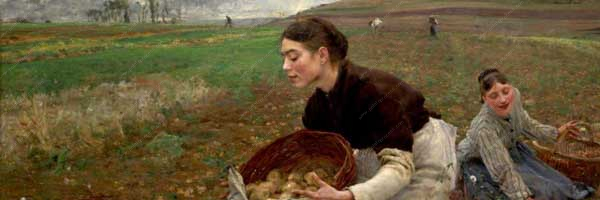A brief history of that most noble tuber: The Potato
All 4,500 named varieties of potatoes trace their ancestry to the Americas. Wild potatoes grow along the American cordillera, the mountains that run from the Andes to Alaska.
People living on its slopes have been eating potatoes for time out of mind. Stone tools and preserved potato peels show that wild potatoes were being prepared for food in southern Utah and south-central Chile nearly 13,000 years ago; similar evidence dates their domestication from at least 7800 BCE on the northern coast of Peru. They formed an important part of the diet of many of the cultures inhabiting the 9000 kilometers between Utah and Chile.
Together with foods such as quinoa and maize, they provided a robust, starchy backbone to cuisines also enriched with chile peppers, beans and other vegetables. Each variety can be propagated from a “mother potato.” She sounds like an ancient deity but in botany the term refers to the mundane tuber or seed potato that provides the genetic material from which additional plants are cultivated.
One difficulty with potatoes is that they are difficult to store. Anyone who has ever lost track of a bag of potatoes knows this. They have an unfortunate tendency to send forth a tangle of roots, and, worse, rot into a foul-smelling puddle.
Andean peoples solved this problem by freeze-drying. Exposing potatoes to the intense cold of the high mountains transforms them into little fists of stone, immune to decay. The technique also neutralizes the poisonous glycoalkaloids present in some of the bitter varieties, allowing these to be eaten safely. If the potato-rocks are trampled underfoot like petrified grapes, it is possible to reduce them to a dry powder that lasts for years.
This dried substance, chuño, captivated Spaniards when they first encountered it in the 16th century, and they invariably described in some detail how it is made. Europeans were however slow in adopting it themselves; it was left to industrial manufacturers in the 20th century to bring us Smash and other commercially produced instant mashed potatoes.
Because potatoes were an essential part of the daily diet in the Andean world, their cultivation was a matter of importance. Various rituals helped ensure an abundant harvest. One account from 16th-century Peru describes the festivities that marked the inauguration of the planting season in the mountain village of Lampa. Local dignitaries seated themselves on carpets to watch the proceedings.
A procession of richly attired attendants accompanied the seed potatoes, which were carried by six men making music on drums. Events culminated with the sacrifice of a particularly beautiful llama, whose blood was immediately sprinkled on the potatoes. Comparable practices (not necessarily involving llama blood) persist to the present day. Spanish priests objected strongly to these ceremonies but were often powerless to prevent them.
The Andean writer Felipe de Guaman Poma de Ayala described the agricultural potato cycle in an extraordinary manuscript that he composed in the early 17th century, after the arrival of Europeans. The son of indigenous nobility, Guaman Poma was born shortly after the Spanish conquest of his homeland. Late in his life he was moved to recount the history that he had to some extent witnessed first-hand.
Guaman Poma’s New Chronicle, as he titled the 1,000-page text, offered a universal history of the world, from Adam and Eve, through the Inca monarchs, to the dismal period of Spanish rule, whose multiple evils Guaman Poma documented in detail.
It also described the ritual calendars of both Christian and Incaic religions, and the agricultural tasks carried out each month. The chronicle is illustrated lavishly with Guaman Poma’s idiosyncratic and immensely appealing line drawings. Several show the labor required to cultivate the essential potato.
Digging sticks in hand, a man and woman weed the field in the picture for June, while a second woman ports a heavy sack away for storage. Other drawings depict men and women at work sowing seed potatoes and tending the abundant plants.
Company Profile
Adhering to the principle of managing scientifically and honesty and credit,our factory has passed ISO9001-2000 quality system certification. Now, Our factory can provide potato dry cleaning machine, automatic potato washing peeling machine, potato peeling machine, french fries sticks cutting machine, potato grader, potato cleaning and sorting machine, potato chips production line, french fries production line, frozen french fries production line, wave shape french fries production line, potato starch production line, potato mesh bag packing machine, potato dosing packing machine.
Our potato processing products have passed with CE,ISO and SGS Certificates and has been widely sold all over the world


